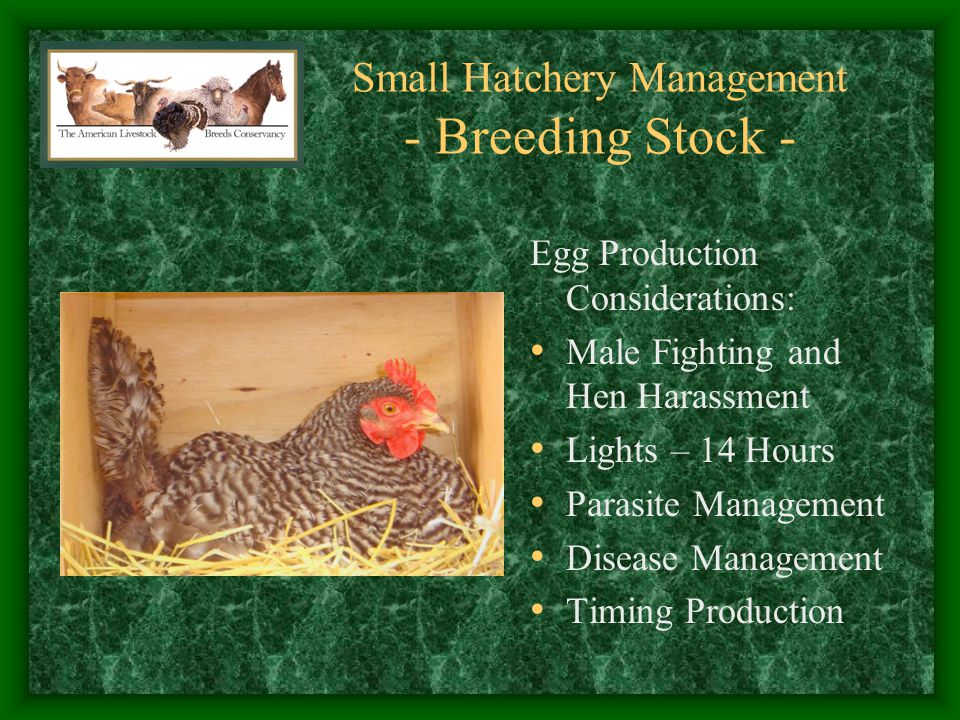
You will need at least 1.5 square feet of floor space per bird, covered with clean straw, wood shavings, or sawdust. One feed pan usually provides enough space for 20 birds. Sufficient watering equipment should be available for 20 birds per cup, 12 birds per nipple, or 1 bird per linear inch of trough space. Birds do not lay eggs at the same time, so nests can be supplied at the rate of one nest per five hens. Nest box bedding should be different from floor litter and must be kept clean and dry.
Lighting stimulates hens to lay eggs. If you want to produce eggs year-round, you will need to install adequate lighting in your facility. Gradually increase the length of time hens are exposed to light when they arrive at your farm. Start with 12 hours of total light per day at an indoor intensity that just allows you to read the fine print of a newspaper at night (0.5- to 1.0-foot candles). Increase daylight length by 30 minutes per week until you reach 16 hours of light per day. Additional outside light exposure is fine; you should just have the supplementary lights begin and remain on before and after dawn and dusk.
Ventilation of poultry enclosures is necessary so that adequate air exchange can take place to keep littered floors dry. Ventilation needs will vary with ambient temperature. If the temperature is too hot or cold for you, it will be for your layers as well. Misting water around the outside of poultry enclosures may be necessary to keep your layers cool during the extreme heat of summer months. Additional litter materials may be necessary to provide insulation during the winter can aid to protect hens from cold floors and drafts.
Conventional layer mash feed can be purchased at your local feed store. Certified organic feeds are also available, but they are sometimes more difficult to find and are more costly. All hen mash should contain at least 3.5 percent calcium and 16 percent crude protein. Additional free-choice calcium may be provided after birds are 45 weeks old to aid in good shell formation, especially during hot weather. Water should be given free choice, and container-based watering systems should be emptied and cleaned every other day at a minimum. Use a bucket to carry waste water away from living areas to reduce the potential for disease and to prevent the litter from becoming damp or wet.
This publication outlines conventional and organic cage-free production methods. The conventional method recommends molting the flock to stimulate a return to laying. Molting involves resting the hen for a short period of time with cessation of lay. This is done by reducing the hours of daily light back to the day length utilized during pullet rearing (10 hours) and feeding a lower energy and calcium diet--more like a pullet's diet. This modification in feed and light will result in an involution of the oviduct and a rebuilding of this organ. After a period of rest and rebuilding, normal feeding and light schedules are resumed. This production practice extends the flock's productive life without replacing the flock. Molting also increases egg size and quality for a period of time. Flocks may be molted more than one time, but this is not recommended for small flocks.
Many breeds are suitable for producing organic eggs. However, usually the brown egg layers with larger, heavier body types have better value as meat value and greater return after laying has ceased.
Authors get paid when people like you upvote their post.
If you enjoyed what you read here, create your account today and start earning FREE STEEM!
If you enjoyed what you read here, create your account today and start earning FREE STEEM!
Hi! I am a robot. I just upvoted you! I found similar content that readers might be interested in:
https://extension.psu.edu/downloadable/download/sample/sample_id/81/
Downvoting a post can decrease pending rewards and make it less visible. Common reasons:
Submit